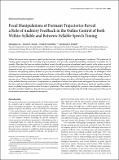Focal Manipulations of Formant Trajectories Reveal a Role of Auditory Feedback in the Online Control of Both Within-Syllable and Between-Syllable Speech Timing
Author(s)
Ghosh, Satrajit S.; Guenther, Frank H.; Perkell, Joseph S.; Cai, Shanqing
DownloadCai-2011-Focal manipulations.pdf (1.267Mb)
PUBLISHER_POLICY
Publisher Policy
Article is made available in accordance with the publisher's policy and may be subject to US copyright law. Please refer to the publisher's site for terms of use.
Terms of use
Metadata
Show full item recordAbstract
Within the human motor repertoire, speech production has a uniquely high level of spatiotemporal complexity. The production of running speech comprises the traversing of spatial positions with precisely coordinated articulator movements to produce 10–15 sounds/s. How does the brain use auditory feedback, namely the self-perception of produced speech sounds, in the online control of spatial and temporal parameters of multisyllabic articulation? This question has important bearings on the organizational principles of sequential actions, yet its answer remains controversial due to the long latency of the auditory feedback pathway and technical challenges involved in manipulating auditory feedback in precisely controlled ways during running speech. In this study, we developed a novel technique for introducing time-varying, focal perturbations in the auditory feedback during multisyllabic, connected speech. Manipulations of spatial and temporal parameters of the formant trajectory were tested separately on two groups of subjects as they uttered “I owe you a yo-yo.” Under these perturbations, significant and specific changes were observed in both the spatial and temporal parameters of the produced formant trajectories. Compensations to spatial perturbations were bidirectional and opposed the perturbations. Furthermore, under perturbations that manipulated the timing of auditory feedback trajectory (slow-down or speed-up), significant adjustments in syllable timing were observed in the subjects' productions. These results highlight the systematic roles of auditory feedback in the online control of a highly over-learned action as connected speech articulation and provide a first look at the properties of this type of sensorimotor interaction in sequential movements.
Date issued
2011-11Department
Harvard University--MIT Division of Health Sciences and Technology; Massachusetts Institute of Technology. Research Laboratory of Electronics; McGovern Institute for Brain Research at MIT; Picower Institute for Learning and MemoryJournal
Journal of Neuroscience
Publisher
Society for Neuroscience
Citation
Cai, S. et al. “Focal Manipulations of Formant Trajectories Reveal a Role of Auditory Feedback in the Online Control of Both Within-Syllable and Between-Syllable Speech Timing.” Journal of Neuroscience 31.45 (2011): 16483–16490.
Version: Final published version
ISSN
0270-6474
1529-2401